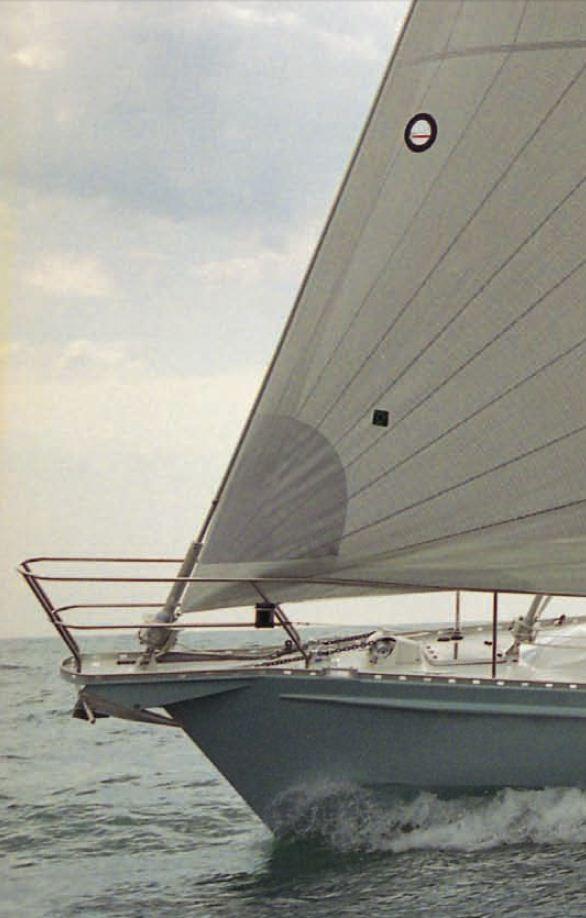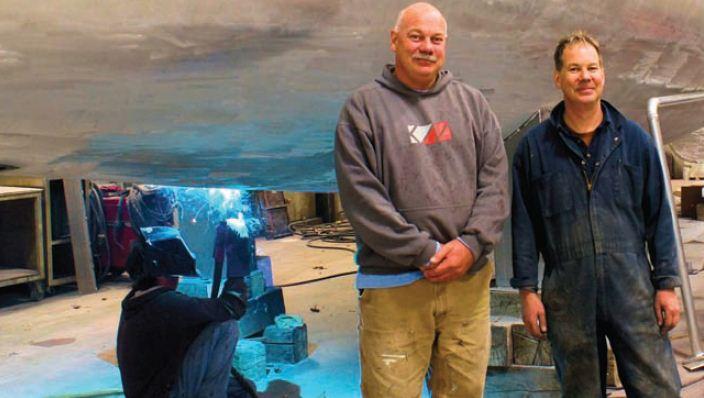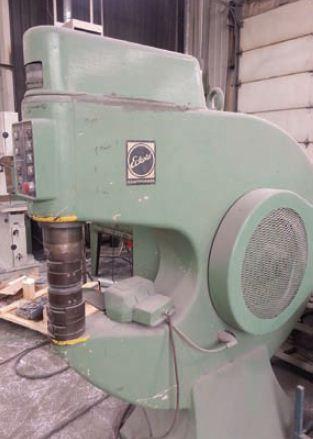- FMA
- The Fabricator
- FABTECH
- Canadian Metalworking
SME Success Stories: World Cruising
Kanter Marine builds world-class yachts.
- By Nestor Gula
- August 5, 2014
- Article
- Fabricating
The depth and strength of the Canadian manufacturing sector is very broad. This manufacturing prowess does not just exist in the big conglomerates which have shops across Canada but in small specialized facilities dotted throughout the land.
Although unfamiliar to many Canadians, Kanter Marine is known throughout the sailing world as a premier builder of custom steel and aluminium yachts. Their yachts are not built for the casual sailor but for mariners who want to sail long distances, crossing oceans, exploring exotic islands and circumnavigating the globe. As they are meant to conquer the seven seas reliably and comfortably, they’re not small boats; the sailing yachts start at 47 feet and go up. Construction time is more than a year on a cruising yacht – typically 14 to 24 months. This is a labour intense operation with a high investment. Since most of their work is custom, pricesvary but their cruising yachts start at under one million dollars to a high of 3 million. “We don’t try to compete with the production builders that build multiples of boats,” said manager Manfred Kantor, Jr.
Located in St. Thomas, Ontario, a short drive south of London, Kanter Marine occupies two medium sized facilities where they build their large sailing vessels and commercial water craft. The business started in 1977 by Manfred Kanter. He came to Canada in 1962 with his wife Lisa. “He came to Canada for a better life, more room and a new start,” according to Manfred Jr. “I don’t think that he was of the mind to start boat building when he came to Canada. He got involved in sailing early on when he came to Canada. He had a six-meter boat which was a prestigious class of sail boats.”
He studied boat building in Hanover and with that knowledge built his first boat. “When my brother and Iwere young he built his first boat which we as a family cruised not around the world, but a good bit of the world, for three years.” Manfred Jr. was ten and his brother Christopher, who is a co-manager of Kanter Marine, was seven when they set off on the adventure. “We cruised the Caribbean, the US Atlantic coast, the Carolinas, Virgin Islands for one year. Crossed the Atlantic to the Azores, England, Holland, where we spent a winter, Spain, Portugal, Madeira, the Canary Islands, sailed back to the Caribbean for a third winter and home in the spring.”
This first boat was constructed out of Cor-Ten steel. “Cor-Ten is an alloy of steel that is often used to build bridges; it does not perforate, it only rusts on the surface. The thought was that the metal boat would have a longer life,” said Manfred Jr. On arrival back to Canada he was asked to build a boat for an acquaintance and Kanter Marine was born. “The very first boat that was built under the name Kanter Yachts was a 24-foot aluminium sail boat,” he said. “It is presently in our yard and we will update it. It has been actively sailed since 1977 in the Great Lakes. Picked it up in Long Point. One of our past employees had it most recently and we bought it from them.” Most of the boats built by Kanter Marine are still sailing and this is a testament to the excellent construction techniques and the care that is exhibited by the company.
In the early days they built a lot of boats out of steel and it evolved into aluminium, as aluminium became more accepted in boat building. Kanter Marine is strictly a builder of boats. They don’t do any of the design work and get the designs from naval architects that they choose or that the customer supplies. Besides sailing yachts they also do some power yachts and have expanded into a series of smaller commercial vessels.
The business started building boats in Port Stanley, a town on Lake Erie some ten kilometres south of St. Thomas. “We were in some leased property and although it was nice to be right on the water, the building was not ideal for what we were doing so we moved to St. Thomas in the early 1980s,” he said. In classic family business tradition, both Manfred Jr. and Christopher have worked at Kanter Marine since their teens – as summer jobs and part-time during the year and then moving to full time as they finished school. The decision to enter the family business was easy for both brothers. “We saw the business grow and support our family reasonably well. I think it is a very interesting career. You create things out of plates of steel and aluminium. You build it until it leaves and then you hear about it years later as it is sailing across every ocean, doing expeditions in Antarctica” said Manfred Jr. “It is pretty rewarding. I don’t know what else I would do. There are a lot of things that would be much easier than this.” He said his dad, Manfred Sr. is still involved. “He oversees everything. As my father, he will always be the CEO but me and my brother Chris are the two officials in the company.”
[gallery type="slideshow" link="none" ids="104697,104699,104700,104702"]
There have been many changes to the industry although the basic methods of boat building have not changed. The frame is constructed and then shaped metal panels are placed in the appropriate places, welded together and ground smooth. “The boats we make were and are hand made,”he said. In the past the boats were much simpler, not in the hull shape or design, although there have been some evolution of hull design for efficiencies and performance, but in the complexity of the electronic systems. “In those days you did not have anywhere near the complexity of systems of navigation, aids to make it easier and faster. It gives the ability to handle a boat with fewer people.”
While the method of construction has not changed much the equipment to manufacture the yachts has. When they started, all metal panels were cut with oxy-acetylene torches. As the company grew they moved to hand-held plasma cutting. “Now we use CNC plasma cutting,” said Manfred Jr. “We have not gone to water jet because plasma provides suitable accuracy for our needs. We would not cut more that 1/2-inch aluminium or steel. There are some components that are thicker. But as far as hull plating it would not be more than 1/2–inch. It is thicker on the bottom and gets lighter as it goes up. We recently upgraded to a much larger table, a 12 by 24-foot table and a Hypertherm power source.” They bought this unit used from a neighbouring company that was upgrading their equipment. “There is no way we would be able to remain competitive without the efficiency that a CNC plasma table offers,” Manfred Jr, notes. He said that if the economy allows, he would not mind getting a water jet system to cut the metal.
The welding of the vessels is all done with hand-held welders. Manfred Jr. does not really see where automating this process would work for Kanter Marine as most of the work they do is custom order. Their first welder was a Miller power source that had an AC TIG module on top. “We had that until recently,” he said. “You could weld steel with that machine and then TIG aluminium.” They recently purchased two Fronius welding machines. “We were working on a couple of Coast Guard pollution response vessels that required a high quality level of welds,” he said .The specifications called for all the welds to be x-rayed so they made a decision to upgrade their welding power sources. “Now we are using computer-controlled cutting and better welding machines. There are more efficiencies,” he said.
The main shop, where the boats are built is about 8,000 square feet. The other building houses the offices and the wood shop for the boat interiors. Manfred Jr. said that the biggest boat they built at the shop was 123-foot long and its bow jutted out of the building. During our visit, there wasn’t much machinery in the building as the space was dominated by the nearly completed hull of a 53-foot yacht. The CNC plasma table occupies one corner of the space while the opposite corner houses some machining equipment that includes a shear, a brake, a lathe and a massive metal forming tool made by the Swiss-German firm Eckold. This machine forms the cut plates to the proper contours to fit the hull profile. Most of the hull work is done by the two welding units and a selection of hand grinders.
As boat builders, Kanter Marine must make boats to a variety of standards. “We have our own in-house QA,” said Manfred Jr. All welders have the proper “tickets” including the CWD47.2 – Fusion Welding of Aluminium. He said that there are no general standards for boat building. When nothing is specified in the contract they use the ABYC (American Boat and Yacht Council) standards that pertain to the majority of the boats. Some are CE certified for a European vessel and other have Lloyd’s Register. All commercial boats built by Kanter Marine have to be Transport Canada certified.
Manfred Jr. said the economic downturn has affected their business by slowing down orders for the pleasure yachts. This was one of the reasons they ramped up their involvement in building commercial vessels. “The commercial boats are more demanding in terms of documentation, correspondence and record keeping. It is a challenge. We have done some 60mph- plus boats for the RCMP with shock mitigating seats and other high-tech features. It is also rewarding to make a large pleasure boat.” There is an added benefit to making the two types of boats. “The commercial business teaches us. It produces a better yacht in our opinion. Some of the things that are more carefully done on a commercial boat, done to a higher standard than on a pleasure boat, we carry that over to the yachts. And vice versa,” he said. “Yachts demand a higher level of finish that we can work into our commercial vessels. It makes the boat better. It is important to be diversified.”
A roadblock for their commercial business is the United States. “It is difficult for a Canadian company to sell commercial vessels to the US,” he said. “You have to build the boat in the US. Some Canadian and other non-US yards set up facilities to build the whole or part of the boat there.” This is due to the Merchant Marine Act of 1920 commonly referred to as the Jones Act. It stipulates that “all goods transported by water between U.S. ports be carried on U.S.-flag ships, constructed in the United States.”
In all Manfred Jr. expects Kanter Marine to continue operation for the foreseeable future. “We hope to be doing this for another 30 or more years. My brother and I both have children and the hope is that the children can carry the company forward,” he said. “Yacht building, big or small, pleasure or commercial, is quite sluggish, but there are signs that it will end soon. We are building one nice yacht project now and we are talking to some other people about various projects as well.”
About the Author
subscribe now


Keep up to date with the latest news, events, and technology for all things metal from our pair of monthly magazines written specifically for Canadian manufacturers!
Start Your Free Subscription- Trending Articles
Portable system becomes hot tech in heat treatment

Cidan Machinery Metal Expo 2024 to be held in Georgia May 1-2

CWB Group launches full-cycle assessment and training program

Achieving success with mechanized plasma cutting

3D laser tube cutting system available in 3, 4, or 5 kW

- Industry Events
MME Winnipeg
- April 30, 2024
- Winnipeg, ON Canada
CTMA Economic Uncertainty: Helping You Navigate Windsor Seminar
- April 30, 2024
- Windsor, ON Canada
CTMA Economic Uncertainty: Helping You Navigate Kitchener Seminar
- May 2, 2024
- Kitchener, ON Canada
Automate 2024
- May 6 - 9, 2024
- Chicago, IL
ANCA Open House
- May 7 - 8, 2024
- Wixom, MI


















